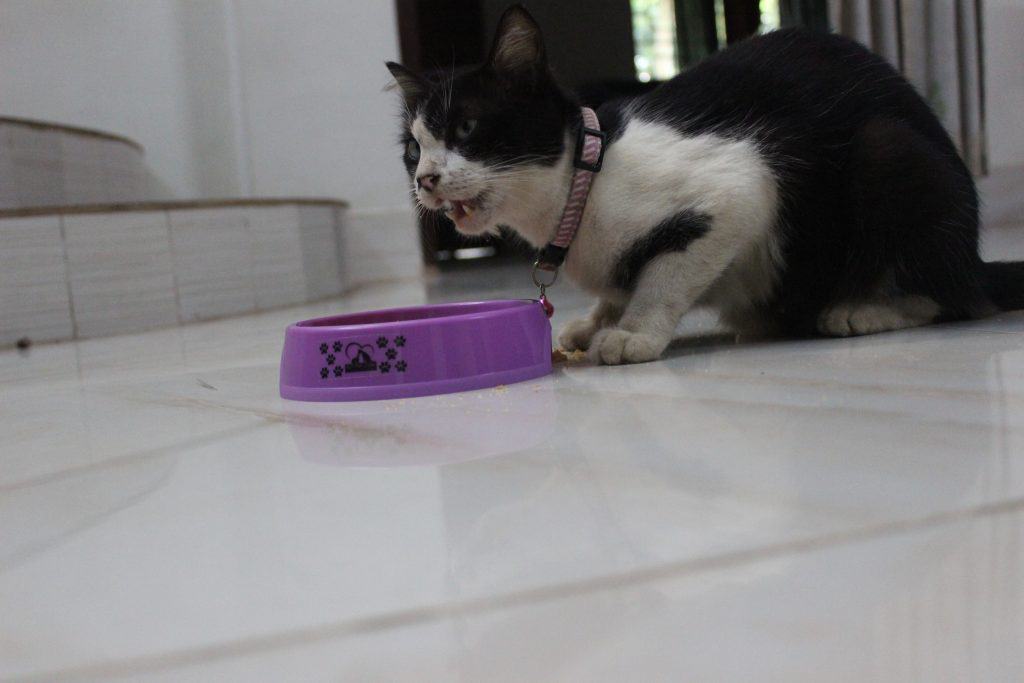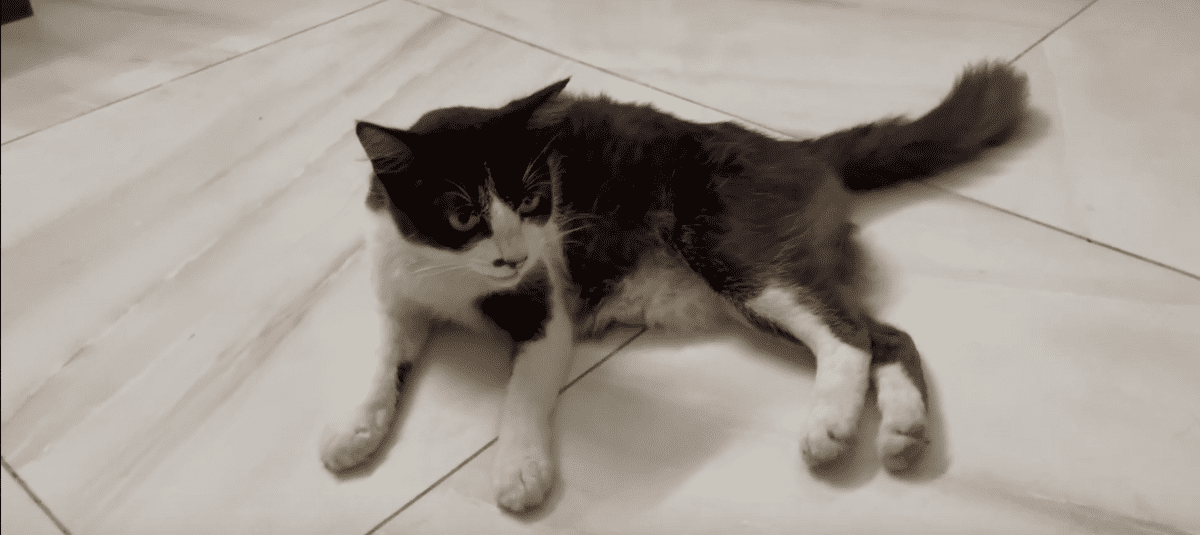Perhaps you don’t know this, but a broken pelvis accounts for approximately 25% of all fractures in cats. Sadly, a fractured pelvis sometimes causes a narrowed or deformed pelvic canal, leading to severe constipation or even complete inability to defecate in cats. But what does it mean when a cat with a broken pelvis is not pooping? And more importantly, what should you do?
When your cat is not pooping following a broken pelvis, it often means she is suffering from obstipation. This is a serious condition where a cat cannot pass stool at all due to severe, intractable constipation, leading to a build-up in the colon. Besides a narrowed pelvic canal, obstipation can occur due to diet changes, nerve damage, reduced mobility, stress, or pain. It’s crucial to understand that prolonged obstipation can be life-threatening and requires immediate veterinary attention.
So then, what do you do when your cat does not poop after sustaining a broken pelvis? I will tell you shortly about my experience with my own kitty and what I learned.
What Does It Mean When Cat With Broken Pelvis Is Not Pooping?
My 2-year-8-month-old cat Muezza, a mixed Persian breed, was injured around six months ago. She was hit by a car. After taking her to the vet, an x-ray was done which revealed she had a minor broken pelvis. The vet prescribed some pain relievers for Muezza and recommended cage rest until she recovered fully. This is because the injury was not severe.
On the second day after the accident, our cat was eating and drinking fine. She could also use her tray to urinate. However, for a week, Muezza could not poop.
After taking her back to the vet, I was told that a major complication of a broken pelvis in cats can be a narrowed pelvic canal. Consequently, this often leads to severe constipation or obstipation because stool struggles to pass through the reduced space. Luckily, Muezza started pooping in the second week after the vet administered fluids intravenously on her.
However, I also found out from the vet that there could have been other reasons Muezza did not poop. They included the following:
- Reduced Mobility: Generally, when your cat has a broken pelvis, veterinarians recommend strict cage rest for several weeks to allow the bones to heal. This means your kitty cannot exercise due to mobility issues. On the flip side, lack of exercise can significantly reduce intestinal motility in cats, leading to constipation.
- Diet Changes: Another cause of your kitty with a pelvic fracture not pooping can be sudden diet changes or an imbalanced diet. For example, a lack of fiber or, paradoxically, too much of it can be problematic. Also, giving your cat more dry than wet food can contribute to dehydration and make her stool harder, leading to difficulties in defecation.
- Discomfort and Pain: Sometimes, the pain relief medication prescribed may not be strong enough to ease your kitty’s pelvic pain adequately. As a result, your cat can be scared to defecate, anticipating pain. This can make her hold her stool longer, causing the intestines to reabsorb too much water, making the stool dry and hard. Consequently, it can become impossible for your feline to poop.
- Medication: Several medications, such as opioids used for pain management and certain antibiotics, are known to cause constipation in cats as a side effect. These drugs can potentially slow down bowel movements and reduce gut motility, making it hard for your kitty to poop regularly.
- Stress: A broken pelvis and the subsequent restricted movement in a cage can be incredibly stressful for cats. Sadly, stress can profoundly impact the digestive system, slowing down digestion and potentially leading to obstipation.
- Nerve Damage: The nerves that control crucial bowel movements (like the pudendal nerve or those in the sacral plexus) can be damaged if your cat’s broken pelvis was due to a severe impact, such as a road accident. This can affect the nerves to the pelvic canal or the intestines themselves. When these nerves are compromised, the colon may not contract correctly to allow the stool to move through, leading to severe constipation or even fecal incontinence.
What To Do When Cat with Broken Pelvis Is Not Pooping?
If your feline is doing well but not pooping, and only after consulting your veterinarian to rule out severe complications, you might consider discussing various supportive home care measures. Always follow your vet’s specific instructions for your cat’s recovery.
- Give Plenty of Water
if your feline is drinking and eating very well, you should try increasing their water intake. You can do this by putting warm water in its dry or wet food, or by offering a pet fountain. This can help prevent dehydration and soften the stool in the colon, making it easier to pass.
- Change the Diet
Dietary modification is often an excellent supportive solution. For example, with my cat Muezza, I started giving her foods rich in fiber, such as cooked pumpkin, wheat bran, green beans, and cooked carrots. This is because fiber-rich foods are known to alleviate constipation disorder by adding bulk to the stool and promoting healthy bowel movements. Generally, you should discuss with your veterinarian offering your feline a diet that is rich in fiber. Apart from pumpkin, you can also give your kitty a tiny amount of pureed aloe vera or add a spoonful of olive oil to her food, as olive oil has some mild laxative properties.

Generally, you should discuss with your veterinarian offering your feline a diet that is rich in fiber. Apart from pumpkin, you can also give your kitty a tiny amount of pureed aloe vera or add a spoonful of olive oil to her food, as olive oil has some mild laxative properties.
- Avoid Dry Food
Additionally, you should ideally avoid giving your kitty any dry food while she is recovering from the broken pelvis, as dry food lacks significant moisture. You should instead focus on giving your cat wet food, which contributes to overall hydration and helps keep the stool soft.
- Manual Stimulation
If none of the above solutions seem to work and only if advised by your veterinarian, you might gently try to stimulate your feline to poop. You just need to wet a soft cloth with warm water. Then, very gently rub the cloth around your kitty’s anus.
This can sometimes help stimulate bowel movement. Alternatively, again, only if recommended by your vet, you can try massaging your cat’s belly gently. This can help alleviate any belly discomfort and encourage the stool to move effortlessly via the colon.
Never apply excessive pressure or try to manually extract stool yourself, as this can cause severe internal injury.
When To See a Veterinarian?
It is critical to contact your veterinarian immediately if your cat hasn’t pooped for more than 48 hours, or if they show signs of pain, straining, or lethargy. If your cat still won’t poop after trying all the above home remedies (and after veterinary consultation), you must take her back to see the vet. The vet can treat your cat by:
- Rehydration
At the vet, your cat will likely be given fluids intravenously (IV fluids) for about 24 hours for rehydration. This is a common and effective method to help make the stool softer and easier to eliminate, addressing dehydration that often accompanies obstipation. [Veterinary Hydration Therapy]
- Administering Enema
Alternatively, the vet can administer a specialized enema solution (such as a warm, soapy water or a lactulose solution) to your cat, often under mild sedation or general anesthesia for comfort and safety. This solution helps induce bowel movement by stimulating the contraction of the colon muscles and softening your kitty’s stool, allowing for evacuation.
- Recommending Prescription Medications
Your vet can also prescribe specific medications, including stool softeners (like lactulose) or prokinetics (drugs that stimulate gut motility), to help your cat poop. These drugs help increase the force of the muscle contractions in your kitty’s walls of the colon or soften the stool directly. Never give your cat over-the-counter human laxatives without explicit veterinary instruction.
- Manual Removal
In severe cases where the stool is severely impacted and other methods have failed, your vet may recommend manual removal of the hard stool from the colon. The vet usually removes the compacted stool with a gloved finger while your kitty is under general anesthesia to ensure no pain or injury.
What Happens If You Don’t Treat a Cat With Broken Pelvis Not Pooping?
If the condition of obstipation is left untreated, your kitty could suffer from a subsequent condition called megacolon secondary to the narrowing of the pelvic canal. This is a very serious condition in which the colon may experience massive enlargement and dilation due to chronic fecal retention.
Unfortunately, a megacolon may lead to a life-threatening situation if left untreated, as the colon muscles can become permanently stretched and lose their ability to contract. The good news is that the condition can often be initially managed using enema solutions, specific laxatives, high-fiber diets, and colon-wall stimulants.
But if the disease is very severe and unresponsive to medical management, the best definitive treatment is often a subtotal colectomy. This involves surgically removing the non-functioning parts of the colon to restore normal bowel function.
FAQs
In this section, I will respond to some commonly asked questions about a cat with a broken pelvis not pooping.
Q. How long can a cat go without pooping following a broken pelvis?
The time could vary based on the severity of the fracture, pain levels, and diet of your cat. However, most felines usually go for 3 or more days without pooping due to a broken pelvis, which is a significant concern. Any cat that hasn’t pooped in 48-72 hours, especially with a pelvic fracture, should be seen by a vet immediately.
Q. Should I be concerned if my cat is eating but not pooping after a broken pelvis?
Yes, absolutely. You should be highly concerned. This could be a sign that the pelvis is not healing properly, that your cat is in a lot of pain making her unable to poop, or that she has a serious, potentially life-threatening obstruction. You should also be concerned because your kitty could be developing a narrow pelvic canal, which could quickly lead to a megacolon if not addressed.
Q. Any symptoms to look out for if my cat is not pooping due to a broken pelvis?
Yes, definitely. Watch out for clear signs of discomfort or changes in behavior. For example, if your cat is avoiding the litter box or is not eating as much as it used to. You can also look out for restlessness, hunched posture, crying, or significant straining when your cat is trying to defecate. Another crucial sign to watch out for is abdominal discomfort or pain when you gently touch your cat’s belly.
Final Thoughts
It is common for a cat with a broken pelvis not to poop, and this is a serious issue requiring attention. This happens mostly because of a narrowed pelvic canal, but pain, diet changes, stress, reduced mobility, and some medications can also lead to this problem.
The good news is that supportive home remedies, when guided by your veterinarian, can sometimes help. However, if these remedies don’t work, or if your cat hasn’t pooped for more than two days, I strongly recommend you take your kitty to the vet without delay. Apart from rehydrating your cat, the vet may administer an enema, prescribe appropriate medications, or in severe cases, perform manual stool removal. Unfortunately, if your cat’s obstipation is not treated promptly and effectively, she could suffer from chronic megacolon, which is a severe and debilitating condition. Always prioritize your cat’s health and consult a professional.




